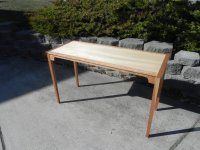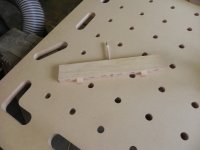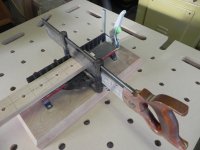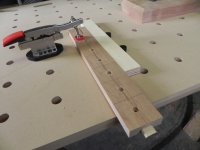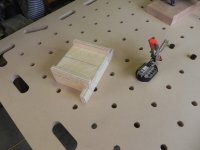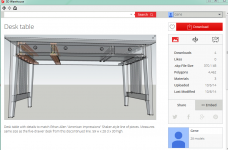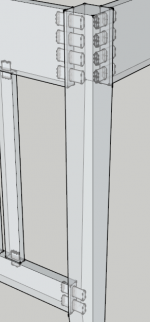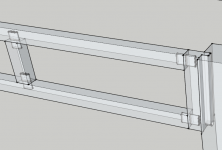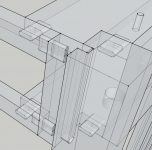clark_fork
Member
- Joined
- Apr 7, 2015
- Messages
- 255
I selected a writing desk as my first Festool Domino Project. A friend rents out a room and needed a writing desk that allowed for both writing and computer work. I modified a plan I had used for building fly-tying desks auctioned off at Trout Un-Limited. Link is below. This is plan found at American Woodworker December 1991. You can Google “Nelson Rittenhouse” to find it. https://books.google.com/books?id=hvsDAAAAMBAJ&pg=PA31&lpg=PA31&dq=nelson+rittenhouse&source=bl&ots=28pGRi9uzu&sig=DDXWZ4sgkRYtAXI8nJEK9eTPkrA&hl=en&sa=X&ei=40M-VbXOE8zuoASh5YDYCA&ved=0CFEQ6AEwDA#v=onepage&q=nelson%20rittenhouse&f=false
This project let me work out several issues. The first was the design issue of adapting a plan with traditional mortise and tenon joints to the Domino system. I also decided to keep the ply top and thus got a chance to try out edging. I would not use the ply top again and if I did, I would miter the edging.
What I learned:
Jig Clutter: I used a jig to taper the legs and another jig to clamp the edging and yet another jig to clamp the legs. This is in addition to construction jigs that check for glue-up squareness, a set that allows for even spacing of Dominos and a simple six sided Domino gauge that helps me with Domino selection. I find I have to find the center often so I used the Domino 500 to create a centering scriber. I used buttons to secure the top and made a jig to keep the Domino 500 from rocking on the narrow aprons. All this clutter convinced me to adopt the MFT process and set a track saw as my next purchase. I am assuming tapered legs are a snap with the track saw. I am assuming since I work with greater than 2 inch thick wood, I will have to spring for the TS-75? A MFT, dogs, clamps and a track saw fence would eliminate the need for most jigs. (Remarkable)
Festool Domino 500: This tool is right up there with my first Woodsmith router table and my first Biesemeyer fence, both of which advanced my woodworking. It is rare something new comes along that changes and challenges the way things have been done. I did some glue-ups for another project and did not use cauls. All components fell into alignment using Dominos. Little things make a difference. The Domino 500 plugs directly into the Midi and the Midi runs when the 500 is operating. The Systainer stacking system brings new organization to my work area. Most folks think Festool sells tools. In my short introduction, I learned Festool is not a tool company; it is an idea. Like a triangle on three sides, one side is health and safety issues, the second side is innovation of functional obsolescence issues, all built on the base of the triangle, which is productivity. The Festool Domino 500 is the perfect example of this triangle. The guards, low noise level, shields, make it safe to use; the vacuum bag but also the filter protects the user from harmful dust. The Domino 500 certainly addresses the functional obsolescence issues of most joinery methods, namely sawed and fitted mortise and tenon joinery. Lastly, the Domino 500 lessens work time compared to any other form of joinery. It increases productivity appealing both to the earning contractor and the leisure time woodworker. Wood Magazine just published a supplement of shop designs. Not one example showed any evidence of the MFT process that I could see. I am puzzled why this concept has not caught on. I don’t know much at this point but I don’t see how any contractor in his right mind would now make wooden doors without the Domino XL 700. On the d/s side (what would I recommend to my daughter or son, given the choice of a typical table saw, a Saw Stop, or a Festool track saw system, why not eliminate all the danger of whatever kind and recommend only the Festool Track saw system?
Belt and suspenders: I used two Dominos for the 76.2mm ( 3 inch) aprons and epoxied corner blocks in to strengthen and square. I almost doweled the Dominos but decided to “just let the chips fall where they might.” I did not gang cut the mortises. I matched each apron with its place on the leg. Next time, I will have more faith and gang cut everything. I have to learn to trust pencil marks or create yet another jig. See Peter Parfitt chair building Video Part 2) Lastly, I was leery of using the button system on narrow aprons so I created a clamp-on platform. As I use the system, I am finding the usefulness of spacers. I made a template of the Domino 500 sole and marked the center line. This helps me determine the width of spacers and distribution of Dominos.
Buttons: I formerly used an apron dado with a cross piece to secure the top. I changed over to buttons, cutting them from a strip that was pre-drilled. By having a strip, I can mortise for the Domino and with my old Miller Falls Mitre box (Kapex Junior) next to me, chop them off until I have enough. The center line on the strip, allows easy placement of the pre-drilled screw holes as well as the center point for the Dominos.
Reveals: The height feature makes it possible to quickly set the height guide with 2 or 3mm difference to allow for a small reveal between the leg and apron making it look like I know what I am doing. Grown men are not supposed to giggle, but working out the reveal with the height guide did make me chuckle when I thought back to the old days of traditional mortise and tenon joinery and all that measuring.
Drawing: This will not be the first plan adapted from traditional mortise and tenon joinery. I draw on paper, set out a cut list and make templates for some work. I am persuaded to learn Sketch-Up and will be working on that for future projects. I am a real estate appraiser and add a drawing of houses I appraise with an Apex software program so I don’t think learning Sketch-Up will be difficult. I bought the Fine Woodworking publication as a start. Does anyone have experience with Sketch-Up in the field on a tablet (Droid)? My appraisal software sketch program works in the field on a tablet.
Finish: While I was at it, I changed from Tung oil sealers and varnishes to a new wipe-on system. I used shellac for the first coat, and then used General Finishes Arm-R-Seal, finishing up with General Finishes Natural Finishing Wax. Good results but shellac is very unforgiving for marks, and glue residue so extra sanding care is in order. Shellac, however, does even out the look of cherry.
Metric: Metric is an easy fit for my needs. I intend to adopt the MFT 20mm system and my work habits will soon go to the dogs (Qwas and Parfs), that is. I am adopting plans with mortise and tenon joinery to Dominos. Plus I have entered the schizophrenic world of Imperial /Metric. I installed a Droid based application (Carpenter’s Calc- $4.00 ). This lets me do the arithmetic of odd fractions from drawings and when I need it, I can covert an inch scale to metric. My Vernier does the same but the Carpenter’s Calc application helps when stacking a set of dimensions.
Light: I had to re-think my shop light system and now have a small halogen work light for mortise cutting on the Domino 500. See suggestions below about lighting the centering line.
Festool Improvements: With all their genius designers, why can’t they find a place to snap on the wrench on the body of the Domino 500 ? I drilled the wrench handle and attached it to a ski-ticket retractable lanyard. At least the company could offer the wrench with a hole in the handle so it could be hung in a visible place or attached to a neck lanyard. Why not build in a light similar to that on the drills for the Domino centering line? Perhaps the future will hold a laser centering line. Festool, please send more than one vacuum bag with the dust collectors. Equip the Domino Systainer with a cradle that can be moved to the work area. I am not comfortable with just letting the expensive Domino 500 lie on the bench. One trip on the cord or vacuum hose and down goes the 500. I intend to fashion a cradle or shelf that can be clamped to the bench where I can set the Domino 500 when not in use. I have seen several good examples on FOG. I will build into it a keeper for the wrench and the extra bits. I may even run up a boom from the cradle to get the hose and cord out of the way. Dovetails? I wonder if Festool will ever introduce a dovetail device. Leigh just introduced a dovetail sled that works on a router table. It would be interesting to see what Festool could design to work with the router table combination. Lastly, Festool should publish decibel levels in all manuals. They were in the Midi manual but not the Domino 500. It might not matter; hearing protection is a must at all times anyway.
FOG: FOG is a museum, encyclopedia, laboratory, auction house, how-to manual, social media network, productivity idea clearing house, better-business-bureau, complaint desk, research institute, video warehouse and much more. I instantly found it an important resource. I grab off tips and ideas and file them away on Evernote. I am grateful for information posted by such luminaries as Peter Parfitt. I have not kept score but I have adopted at least a dozen ideas in the short time viewing FOG.
The Festool Domino was a pleasure to use. I found the learning curve manageable and that mostly centered on the care it takes to make sure the Domino 500 is firmly seated at each cut. Changing cutter height is awkward without some practice. I may figure out a slanted holder to hold the Domino while setting the height guide. The time saving alone, once I climbed the learning curve, is the most winning quality of the Domino 500.
[attachimg=1]
The desk in cherry
[attachimg=2]
"You have to have a scheme" says Peter Parfitt. This helps me keep track of mortise placement
[attachimg=3]
Belt and Suspenders-A platform for making button mortises.
[attachimg=4]
Button System
[attachimg=5]
Kapex Junior in action-no flying buttons
[attachimg=6]
Quick centering scriber
The next item to purchase after I solve the MFT issue will be the track saw. I now have a SF/Steve/Slab and am in the process of building horses.
This project let me work out several issues. The first was the design issue of adapting a plan with traditional mortise and tenon joints to the Domino system. I also decided to keep the ply top and thus got a chance to try out edging. I would not use the ply top again and if I did, I would miter the edging.
What I learned:
Jig Clutter: I used a jig to taper the legs and another jig to clamp the edging and yet another jig to clamp the legs. This is in addition to construction jigs that check for glue-up squareness, a set that allows for even spacing of Dominos and a simple six sided Domino gauge that helps me with Domino selection. I find I have to find the center often so I used the Domino 500 to create a centering scriber. I used buttons to secure the top and made a jig to keep the Domino 500 from rocking on the narrow aprons. All this clutter convinced me to adopt the MFT process and set a track saw as my next purchase. I am assuming tapered legs are a snap with the track saw. I am assuming since I work with greater than 2 inch thick wood, I will have to spring for the TS-75? A MFT, dogs, clamps and a track saw fence would eliminate the need for most jigs. (Remarkable)
Festool Domino 500: This tool is right up there with my first Woodsmith router table and my first Biesemeyer fence, both of which advanced my woodworking. It is rare something new comes along that changes and challenges the way things have been done. I did some glue-ups for another project and did not use cauls. All components fell into alignment using Dominos. Little things make a difference. The Domino 500 plugs directly into the Midi and the Midi runs when the 500 is operating. The Systainer stacking system brings new organization to my work area. Most folks think Festool sells tools. In my short introduction, I learned Festool is not a tool company; it is an idea. Like a triangle on three sides, one side is health and safety issues, the second side is innovation of functional obsolescence issues, all built on the base of the triangle, which is productivity. The Festool Domino 500 is the perfect example of this triangle. The guards, low noise level, shields, make it safe to use; the vacuum bag but also the filter protects the user from harmful dust. The Domino 500 certainly addresses the functional obsolescence issues of most joinery methods, namely sawed and fitted mortise and tenon joinery. Lastly, the Domino 500 lessens work time compared to any other form of joinery. It increases productivity appealing both to the earning contractor and the leisure time woodworker. Wood Magazine just published a supplement of shop designs. Not one example showed any evidence of the MFT process that I could see. I am puzzled why this concept has not caught on. I don’t know much at this point but I don’t see how any contractor in his right mind would now make wooden doors without the Domino XL 700. On the d/s side (what would I recommend to my daughter or son, given the choice of a typical table saw, a Saw Stop, or a Festool track saw system, why not eliminate all the danger of whatever kind and recommend only the Festool Track saw system?
Belt and suspenders: I used two Dominos for the 76.2mm ( 3 inch) aprons and epoxied corner blocks in to strengthen and square. I almost doweled the Dominos but decided to “just let the chips fall where they might.” I did not gang cut the mortises. I matched each apron with its place on the leg. Next time, I will have more faith and gang cut everything. I have to learn to trust pencil marks or create yet another jig. See Peter Parfitt chair building Video Part 2) Lastly, I was leery of using the button system on narrow aprons so I created a clamp-on platform. As I use the system, I am finding the usefulness of spacers. I made a template of the Domino 500 sole and marked the center line. This helps me determine the width of spacers and distribution of Dominos.
Buttons: I formerly used an apron dado with a cross piece to secure the top. I changed over to buttons, cutting them from a strip that was pre-drilled. By having a strip, I can mortise for the Domino and with my old Miller Falls Mitre box (Kapex Junior) next to me, chop them off until I have enough. The center line on the strip, allows easy placement of the pre-drilled screw holes as well as the center point for the Dominos.
Reveals: The height feature makes it possible to quickly set the height guide with 2 or 3mm difference to allow for a small reveal between the leg and apron making it look like I know what I am doing. Grown men are not supposed to giggle, but working out the reveal with the height guide did make me chuckle when I thought back to the old days of traditional mortise and tenon joinery and all that measuring.
Drawing: This will not be the first plan adapted from traditional mortise and tenon joinery. I draw on paper, set out a cut list and make templates for some work. I am persuaded to learn Sketch-Up and will be working on that for future projects. I am a real estate appraiser and add a drawing of houses I appraise with an Apex software program so I don’t think learning Sketch-Up will be difficult. I bought the Fine Woodworking publication as a start. Does anyone have experience with Sketch-Up in the field on a tablet (Droid)? My appraisal software sketch program works in the field on a tablet.
Finish: While I was at it, I changed from Tung oil sealers and varnishes to a new wipe-on system. I used shellac for the first coat, and then used General Finishes Arm-R-Seal, finishing up with General Finishes Natural Finishing Wax. Good results but shellac is very unforgiving for marks, and glue residue so extra sanding care is in order. Shellac, however, does even out the look of cherry.
Metric: Metric is an easy fit for my needs. I intend to adopt the MFT 20mm system and my work habits will soon go to the dogs (Qwas and Parfs), that is. I am adopting plans with mortise and tenon joinery to Dominos. Plus I have entered the schizophrenic world of Imperial /Metric. I installed a Droid based application (Carpenter’s Calc- $4.00 ). This lets me do the arithmetic of odd fractions from drawings and when I need it, I can covert an inch scale to metric. My Vernier does the same but the Carpenter’s Calc application helps when stacking a set of dimensions.
Light: I had to re-think my shop light system and now have a small halogen work light for mortise cutting on the Domino 500. See suggestions below about lighting the centering line.
Festool Improvements: With all their genius designers, why can’t they find a place to snap on the wrench on the body of the Domino 500 ? I drilled the wrench handle and attached it to a ski-ticket retractable lanyard. At least the company could offer the wrench with a hole in the handle so it could be hung in a visible place or attached to a neck lanyard. Why not build in a light similar to that on the drills for the Domino centering line? Perhaps the future will hold a laser centering line. Festool, please send more than one vacuum bag with the dust collectors. Equip the Domino Systainer with a cradle that can be moved to the work area. I am not comfortable with just letting the expensive Domino 500 lie on the bench. One trip on the cord or vacuum hose and down goes the 500. I intend to fashion a cradle or shelf that can be clamped to the bench where I can set the Domino 500 when not in use. I have seen several good examples on FOG. I will build into it a keeper for the wrench and the extra bits. I may even run up a boom from the cradle to get the hose and cord out of the way. Dovetails? I wonder if Festool will ever introduce a dovetail device. Leigh just introduced a dovetail sled that works on a router table. It would be interesting to see what Festool could design to work with the router table combination. Lastly, Festool should publish decibel levels in all manuals. They were in the Midi manual but not the Domino 500. It might not matter; hearing protection is a must at all times anyway.
FOG: FOG is a museum, encyclopedia, laboratory, auction house, how-to manual, social media network, productivity idea clearing house, better-business-bureau, complaint desk, research institute, video warehouse and much more. I instantly found it an important resource. I grab off tips and ideas and file them away on Evernote. I am grateful for information posted by such luminaries as Peter Parfitt. I have not kept score but I have adopted at least a dozen ideas in the short time viewing FOG.
The Festool Domino was a pleasure to use. I found the learning curve manageable and that mostly centered on the care it takes to make sure the Domino 500 is firmly seated at each cut. Changing cutter height is awkward without some practice. I may figure out a slanted holder to hold the Domino while setting the height guide. The time saving alone, once I climbed the learning curve, is the most winning quality of the Domino 500.
[attachimg=1]
The desk in cherry
[attachimg=2]
"You have to have a scheme" says Peter Parfitt. This helps me keep track of mortise placement
[attachimg=3]
Belt and Suspenders-A platform for making button mortises.
[attachimg=4]
Button System
[attachimg=5]
Kapex Junior in action-no flying buttons
[attachimg=6]
Quick centering scriber
The next item to purchase after I solve the MFT issue will be the track saw. I now have a SF/Steve/Slab and am in the process of building horses.

